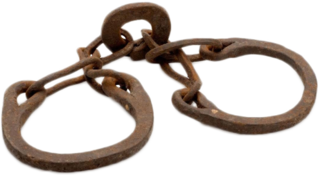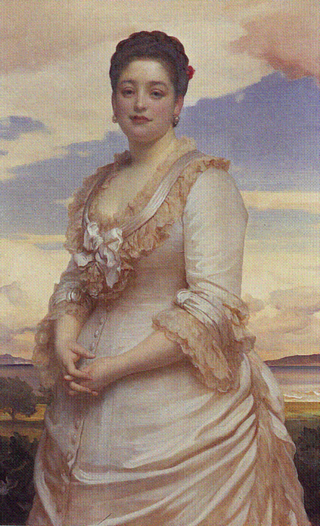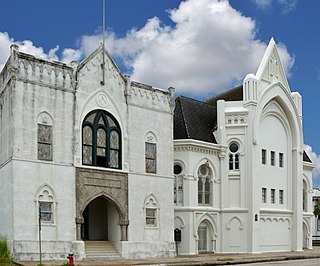
Sexual slavery and sexual exploitation is an attachment of any ownership right over one or more people with the intent of coercing or otherwise forcing them to engage in sexual activities. This includes forced labor that results in sexual activity, forced marriage and sex trafficking, such as the sexual trafficking of children.

Hannah Primrose, Countess of Rosebery was the daughter of Baron Mayer de Rothschild and his wife Juliana. After inheriting her father's fortune in 1874, she became the richest woman in Britain. In 1878, Hannah de Rothschild married Archibald Primrose, 5th Earl of Rosebery, and was thereafter known as the Countess of Rosebery.

The history of the Jews in England goes back to the reign of William the Conqueror. Although it is likely that there had been some Jewish presence in the Roman period, there is no definitive evidence, and no reason to suppose that there was any community during Anglo-Saxon times. The first written record of Jewish settlement in England dates from 1070. The Jewish settlement continued until King Edward I's Edict of Expulsion in 1290.
Forced prostitution, also known as involuntary prostitution or compulsory prostitution, is prostitution or sexual slavery that takes place as a result of coercion by a third party. The terms "forced prostitution" or "enforced prostitution" appear in international and humanitarian conventions, such as the Rome Statute of the International Criminal Court, but have been inconsistently applied. "Forced prostitution" refers to conditions of control over a person who is coerced by another to engage in sexual activity.
The First Aliyah, also known as the agriculture Aliyah, was a major wave of Jewish immigration (aliyah) to Ottoman Palestine between 1881 and 1903. Jews who migrated in this wave came mostly from Eastern Europe and from Yemen, stimulated by pogroms and violence against the Jewish communities in those areas. An estimated 25,000 Jews immigrated. Many of the European Jewish immigrants during the late 19th-early 20th century period gave up after a few months and went back to their country of origin, often suffering from hunger and disease.

Zwi Migdal was a criminal organisation founded by Jews in Poland in the 19th century, based mainly in Argentina.

The Central British Fund for World Jewish Relief formerly Central British Fund for German Jewry (CBF) which currently operates under the name World Jewish Relief (WJR), is a British charitable organisation and the main Jewish overseas aid organisation in the United Kingdom.

Henry Cohen was a British-American rabbi, scholar, community activist and writer who served most of his career at Congregation B'nai Israel in Galveston, Texas, from 1888 to 1949. He came to the United States in 1885, during a period of rapid and massive growth related to early 20th-century immigration from eastern and southern Europe. In Texas, he organized the Galveston Movement, which worked from 1907 to 1914 to attract eastern European Jewish immigrants to Galveston and the Gulf Coast as a destination, as an alternative to the better known Northeastern cities. Ten thousand such immigrants entered at Galveston.

Prostitution in Brazil is legal, in terms of exchanging sex for money, as there are no laws forbidding adults from being professional sex workers, but it is illegal to operate a brothel or to employ sex workers in any other way. Public order and vagrancy laws are used against street prostitutes. The affordability of prostitutes is the most inquired-about term in word completion queries on purchases on Google in Brazil.
Indonesia is a source, transit, and destination country for women, children, and men trafficked for the purposes of commercial sexual exploitation and forced labor. The greatest threat of trafficking facing Indonesian men and women is that posed by conditions of forced labor and debt bondage in more developed Asian countries and the Middle East.

The word ‘pogrom’ is derived from the Russian word 'погром.' In Russia, the word pogrom was first used to describe the anti-Semitic attacks that followed the assassination of Tsar Alexander II in 1881. There was a second wave of pogroms in the early 20th century, between 1903 and 1906. Despite there being only two 'waves' of pogroms, there had been a culture of anti-Semitism existing for centuries.
Austria is a destination and transit country for women, men, and children subjected to trafficking in persons, specifically forced prostitution and forced labor.
Belgium is a source, destination, and transit country for men, women, and children subjected to trafficking in persons, specifically forced labor and forced prostitution. Victims originate in Eastern Europe, Africa, East Asia, as well as Brazil and India. Some victims are smuggled through Belgium to other European countries, where they are subjected to forced labor and forced prostitution. Male victims are subjected to forced labor and exploitation in restaurants, bars, sweatshops, horticulture sites, fruit farms, construction sites, and retail shops. There were reportedly seven Belgian women subjected to forced prostitution in Luxembourg in 2009. According to a 2009 ECPAT Report, the majority of girls and children subjected to forced prostitution in Belgium originate from Balkan and CIS countries, Eastern Europe, Asia and West Africa ; some young foreign boys are exploited in prostitution in major cities in the country. Local observers also report that a large portion of children trafficked in Belgium are unaccompanied, vulnerable asylum seekers and refugees. Criminal organizations from Thailand use Thai massage parlors in Belgium, which are run by Belgian managers, to sexually exploit young Thai women. These networks are involved in human smuggling and trafficking to exploit victims economically and sexually. Belgium is not only a destination country, but also a transit country for children to be transported to other European country destinations.
Greece is a transit, source and destination country for women and children who are subjected to human trafficking, specifically forced prostitution and conditions of forced labor for men, women, and children. Female sex trafficking victims originate primarily in Eastern Europe and former Soviet bloc countries. Traffickers use physical, emotional, and sexual abuse for coercion. Greece's European Union membership, coupled with a shared border with Turkey, means the country sees massive flows of illegal immigrants looking to enter the EU. Traffickers also use Greece not only as a destination but also as transit stop and also as a source country where even Greek women are prostituted on the way to Western Europe.

The International Abolitionist Federation, founded in Liverpool in 1875, aimed to abolish state regulation of prostitution and fought the international traffic in women in prostitution. It was originally called the British and Continental Federation for the Abolition of Prostitution.

Sex trafficking in the United States is a form of human trafficking which involves reproductive slavery or commercial sexual exploitation as it occurs in the United States. Sex trafficking includes the transportation of persons by means of coercion, deception and/or force into exploitative and slavery-like conditions. It is commonly associated with organized crime.

Constance Flower, Baroness Battersea, also known as Lady Battersea, was a society hostess and philanthropist in London who established the Jewish Association for the Protection of Girls, Women and Children in 1885 and was prominent in the Temperance movement in the United Kingdom.
Emily Marion Harris was an English novelist, poet, and social worker. Many of her writings explored Jewish life in London, and the religious and political conflicts of Jewish traditionalists in the face of increasing assimilation.

Kingston upon Hull, on England's East Coast was, by 1750, a major point of entry into Britain for traders and migrants, second only to London for links to the continent. Around then, a few Jews from German and Dutch cities lodged and settled in Hull. Selling jewelry and dealing goods in the thriving port and market town, they maintained contacts with Europe, London, and many other – particularly Northern – towns. The small community produced its own institutions and leaders, which were tested by anti-Jewish sentiment, and later by an influx of East-European refugees.

The early 20th century marked a large period of immigration for Argentina. Prostitution became legalized in 1875. Moreover, due to the Great Depression, another large wave of European immigrants came to Buenos Aires looking for better job opportunities. However, there were cases about women who were tricked into coming to Argentina with the promise of a husband and better life, which turned out to be a pimp for brothels called bordellos.











